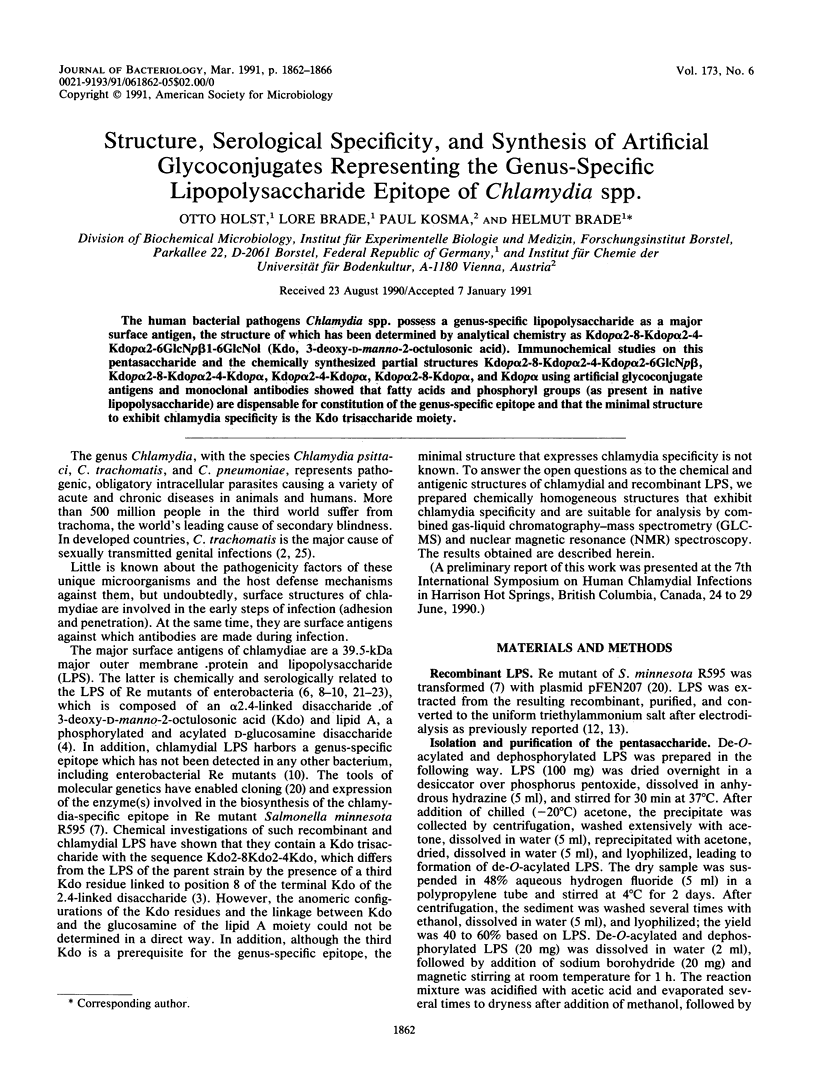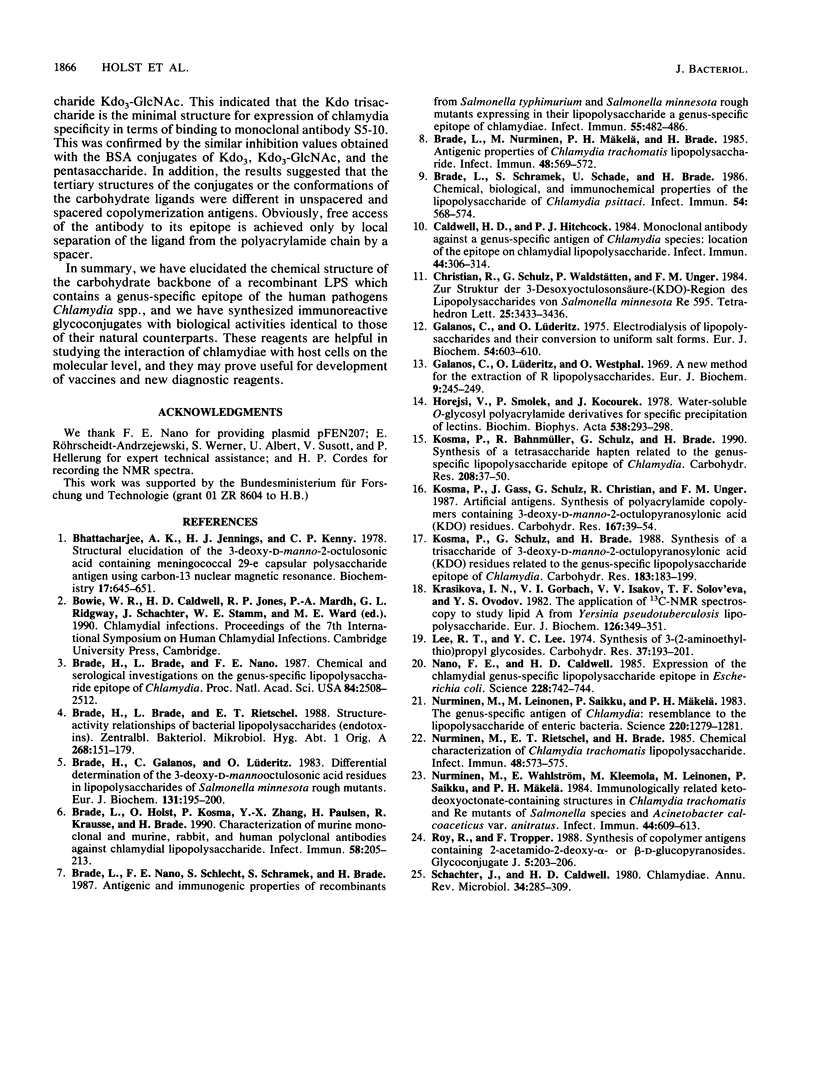Abstract
The human bacterial pathogens Chlamydia spp. possess a genus-specific lipopolysaccharide as a major surface antigen, the structure of which has been determined by analytical chemistry as Kdop alpha 2-8-Kdop alpha 2-4-Kdop alpha 2-6GlcNp beta 1-6-GlcNol (Kdo, 3-deoxy-D-manno-2-octulosonic acid). Immunochemical studies on this pentasaccharide and the chemically synthesized partial structures Kdop alpha 2-8-Kdop alpha 2-4-Kdop alpha 2-6GlcNp beta, Kdop alpha 2-8-Kdop alpha 2-4-Kdop alpha, Kdop alpha 2-4-Kdop alpha, Kdop alpha 2-8-Kdop alpha, and Kdop alpha using artificial glycoconjugate antigens and monoclonal antibodies showed that fatty acids and phosphoryl groups (as present in native lipopolysaccharide) are dispensable for constitution of the genus-specific epitope and that the minimal structure to exhibit chlamydia specificity is the Kdo trisaccharide moiety.
Full text
PDF




Selected References
These references are in PubMed. This may not be the complete list of references from this article.
- Bhattacharjee A. K., Jennings H. J., Kenny C. P. Structural elucidation of the 3-deoxy-D-manno-octulosonic acid containing meningococcal 29-e capsular polysaccharide antigen using carbon-13 nuclear magnetic resonance. Biochemistry. 1978 Feb 21;17(4):645–651. doi: 10.1021/bi00597a013. [DOI] [PubMed] [Google Scholar]
- Brade H., Brade L., Nano F. E. Chemical and serological investigations on the genus-specific lipopolysaccharide epitope of Chlamydia. Proc Natl Acad Sci U S A. 1987 Apr;84(8):2508–2512. doi: 10.1073/pnas.84.8.2508. [DOI] [PMC free article] [PubMed] [Google Scholar]
- Brade H., Brade L., Rietschel E. T. Structure-activity relationships of bacterial lipopolysaccharides (endotoxins). Current and future aspects. Zentralbl Bakteriol Mikrobiol Hyg A. 1988 Apr;268(2):151–179. doi: 10.1016/s0176-6724(88)80001-4. [DOI] [PubMed] [Google Scholar]
- Brade H., Galanos C., Lüderitz O. Differential determination of the 3-Deoxy-D-mannooctulosonic acid residues in lipopolysaccharides of Salmonella minnesota rough mutants. Eur J Biochem. 1983 Mar 1;131(1):195–200. doi: 10.1111/j.1432-1033.1983.tb07249.x. [DOI] [PubMed] [Google Scholar]
- Brade L., Holst O., Kosma P., Zhang Y. X., Paulsen H., Krausse R., Brade H. Characterization of murine monoclonal and murine, rabbit, and human polyclonal antibodies against chlamydial lipopolysaccharide. Infect Immun. 1990 Jan;58(1):205–213. doi: 10.1128/iai.58.1.205-213.1990. [DOI] [PMC free article] [PubMed] [Google Scholar]
- Brade L., Nano F. E., Schlecht S., Schramek S., Brade H. Antigenic and immunogenic properties of recombinants from Salmonella typhimurium and Salmonella minnesota rough mutants expressing in their lipopolysaccharide a genus-specific chlamydial epitope. Infect Immun. 1987 Feb;55(2):482–486. doi: 10.1128/iai.55.2.482-486.1987. [DOI] [PMC free article] [PubMed] [Google Scholar]
- Brade L., Nurminen M., Mäkelä P. H., Brade H. Antigenic properties of Chlamydia trachomatis lipopolysaccharide. Infect Immun. 1985 May;48(2):569–572. doi: 10.1128/iai.48.2.569-572.1985. [DOI] [PMC free article] [PubMed] [Google Scholar]
- Brade L., Schramek S., Schade U., Brade H. Chemical, biological, and immunochemical properties of the Chlamydia psittaci lipopolysaccharide. Infect Immun. 1986 Nov;54(2):568–574. doi: 10.1128/iai.54.2.568-574.1986. [DOI] [PMC free article] [PubMed] [Google Scholar]
- Caldwell H. D., Hitchcock P. J. Monoclonal antibody against a genus-specific antigen of Chlamydia species: location of the epitope on chlamydial lipopolysaccharide. Infect Immun. 1984 May;44(2):306–314. doi: 10.1128/iai.44.2.306-314.1984. [DOI] [PMC free article] [PubMed] [Google Scholar]
- Galanos C., Lüderitz O. Electrodialysis of lipopolysaccharides and their conversion to uniform salt forms. Eur J Biochem. 1975 Jun;54(2):603–610. doi: 10.1111/j.1432-1033.1975.tb04172.x. [DOI] [PubMed] [Google Scholar]
- Galanos C., Lüderitz O., Westphal O. A new method for the extraction of R lipopolysaccharides. Eur J Biochem. 1969 Jun;9(2):245–249. doi: 10.1111/j.1432-1033.1969.tb00601.x. [DOI] [PubMed] [Google Scholar]
- Horejsí V., Smolek P., Kocourek J. Studies on lectins. XXXV. Water-soluble O-glycosyl polyacrylamide derivatives for specific precipitation of lectins. Biochim Biophys Acta. 1978 Jan 18;538(2):293–298. doi: 10.1016/0304-4165(78)90357-4. [DOI] [PubMed] [Google Scholar]
- Kosma P., Bahnmüller R., Schulz G., Brade H. Synthesis of a tetrasaccharide of the genus-specific lipopolysaccharide epitope of Chlamydia. Carbohydr Res. 1990 Dec 15;208:37–50. doi: 10.1016/0008-6215(90)80083-f. [DOI] [PubMed] [Google Scholar]
- Kosma P., Gass J., Schulz G., Christian R., Unger F. M. Artificial antigens. Synthesis of polyacrylamide copolymers containing 3-deoxy-D-manno-2-octulopyranosylonic acid (KDO) residues. Carbohydr Res. 1987 Sep 15;167:39–54. doi: 10.1016/0008-6215(87)80266-5. [DOI] [PubMed] [Google Scholar]
- Kosma P., Schulz G., Brade H. Synthesis of a trisaccharide of 3-deoxy-D-manno-2-octulopyranosylonic acid (KDO) residues related to the genus-specific lipopolysaccharide epitope of Chlamydia. Carbohydr Res. 1988 Dec 1;183(2):183–199. doi: 10.1016/0008-6215(88)84073-4. [DOI] [PubMed] [Google Scholar]
- Krasikova I. N., Gorbach V. I., Isakov V. V., Solov'eva T. F., Ovodov Y. S. The application of 13C-NMR spectroscopy to study lipid A from Yersinia pseudotuberculosis lipopolysaccharide. Eur J Biochem. 1982 Aug;126(2):349–351. doi: 10.1111/j.1432-1033.1982.tb06786.x. [DOI] [PubMed] [Google Scholar]
- Lee R. T., Lee Y. C. Synthesis of 3-(2-aminoethylthio)propyl glycosides. Carbohydr Res. 1974 Oct;37(1):193–201. doi: 10.1016/s0008-6215(00)87074-3. [DOI] [PubMed] [Google Scholar]
- Nano F. E., Caldwell H. D. Expression of the chlamydial genus-specific lipopolysaccharide epitope in Escherichia coli. Science. 1985 May 10;228(4700):742–744. doi: 10.1126/science.2581315. [DOI] [PubMed] [Google Scholar]
- Nurminen M., Leinonen M., Saikku P., Mäkelä P. H. The genus-specific antigen of Chlamydia: resemblance to the lipopolysaccharide of enteric bacteria. Science. 1983 Jun 17;220(4603):1279–1281. doi: 10.1126/science.6344216. [DOI] [PubMed] [Google Scholar]
- Nurminen M., Rietschel E. T., Brade H. Chemical characterization of Chlamydia trachomatis lipopolysaccharide. Infect Immun. 1985 May;48(2):573–575. doi: 10.1128/iai.48.2.573-575.1985. [DOI] [PMC free article] [PubMed] [Google Scholar]
- Nurminen M., Wahlström E., Kleemola M., Leinonen M., Saikku P., Mäkelä P. H. Immunologically related ketodeoxyoctonate-containing structures in Chlamydia trachomatis, Re mutants of Salmonella species, and Acinetobacter calcoaceticus var. anitratus. Infect Immun. 1984 Jun;44(3):609–613. doi: 10.1128/iai.44.3.609-613.1984. [DOI] [PMC free article] [PubMed] [Google Scholar]
- Schachter J., Caldwell H. D. Chlamydiae. Annu Rev Microbiol. 1980;34:285–309. doi: 10.1146/annurev.mi.34.100180.001441. [DOI] [PubMed] [Google Scholar]


